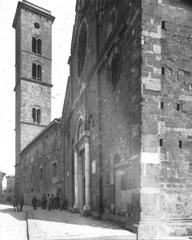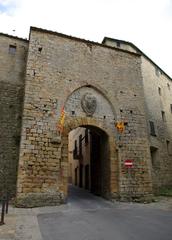Castello di Monte Voltraio: Visiting Hours, Tickets, and Travel Guide – Volterra, Italy
Date: 14/06/2025
Introduction: A Fortress of History and Heritage
Perched on a commanding hilltop overlooking the Cecina Valley near Volterra, Castello di Monte Voltraio is a remarkable testament to Tuscany’s medieval legacy. This fortress, with origins tracing back to the early Middle Ages, played a pivotal role in the region’s defense, governance, and cultural development. Throughout centuries of power struggles between rival city-states such as Florence, Pisa, and Siena, Monte Voltraio stood as both a military stronghold and a symbol of local resilience, shaping the identity of Volterra and its surroundings (volterracity.com).
Today, visitors are welcomed to explore evocative ruins that offer sweeping panoramic views and a tangible connection to the past. Whether you’re a history enthusiast, a hiker, or a traveler seeking authentic Tuscan experiences, this guide provides comprehensive insights into Castello di Monte Voltraio’s history, practical visitor information, ticketing, travel tips, nearby attractions, and more (tenutedelcerro.it).
Table of Contents
- Early Origins and Strategic Importance
- Medieval Expansion and the Bishops’ Role
- Conflict, Destruction, and Rebuilding
- Decline and Abandonment
- Archaeological Significance and Modern Rediscovery
- Culture, Legends, and Local Memory
- Visiting Information: Hours, Tickets, and Accessibility
- Travel Tips and Nearby Attractions
- Photographic Spots and Visitor Tips
- Frequently Asked Questions (FAQ)
- Preservation and Visitor Experience
- Practical Itinerary and Final Thoughts
- References
Early Origins and Strategic Importance
Castello di Monte Voltraio’s history is deeply intertwined with Volterra’s strategic significance in medieval Tuscany. Its elevated position was ideal for defense and for controlling trade and communication routes. Likely established in the early Middle Ages to protect local populations after the fall of Roman authority, the site was fortified to serve as both lookout and safe haven in turbulent times (volterracity.com).
Medieval Expansion and the Bishops’ Role
By the 10th and 11th centuries, Volterra had become a regional power center, and the bishops of Volterra—who held both secular and religious authority—invested in strengthening Monte Voltraio’s defenses. The castle functioned as a linchpin in the city’s military network and as a symbol of the bishop’s governance. Central keeps, curtain walls, and ancillary buildings enabled the site to serve as a refuge and administrative hub, reinforcing Volterra’s control over vital routes and rural territories (wanderlog.com).
Conflict, Destruction, and Rebuilding
Throughout the 12th and 13th centuries, Tuscany was fraught with conflict. Monte Voltraio endured repeated sieges and damage as Volterra faced threats from Florence, Pisa, and Siena. The castle’s fortifications were breached and rebuilt multiple times, reflecting Volterra’s tenacity and the importance of Monte Voltraio in maintaining autonomy during an era of shifting alliances and frequent warfare (tenutedelcerro.it).
Decline and Abandonment
With the advent of gunpowder and the consolidation of larger political entities, hilltop castles like Monte Voltraio lost their military relevance. By the 15th century, the fortress was largely abandoned; its stones were repurposed, and nature began to reclaim the site. Nevertheless, the ruins remained a powerful symbol of the region’s medieval past (wanderlog.com).
Archaeological Significance and Modern Rediscovery
Modern archaeological work has revealed layers of construction, daily life artifacts, and evidence of extensive trade connections. Pottery, metalwork, and architectural fragments unearthed at Monte Voltraio provide valuable insights into the economic and social networks that once linked Volterra to the Mediterranean world (tenutedelcerro.it).
Culture, Legends, and Local Memory
The fortress is woven into local folklore, with legends attributing its construction to legendary figures and tales of hidden treasures, such as the “Hen with the Golden Chicks.” Festivals, guided walks, and educational programs keep Monte Voltraio’s stories alive and reinforce its role in local identity (volterracity.com).
Visiting Information: Hours, Tickets, and Accessibility
Opening Hours
- Standard Hours: 9:00 AM to 6:00 PM daily (may vary seasonally).
- Summer Months: Extended hours; check official websites for updates.
Tickets
- Volterra Side: Admission is typically free; donations for preservation are welcome.
- Elba/Portoferraio Side: Admission is €8 for adults, €5 for seniors and students, and free for children under 12 (Castello di Monte Voltraio official website).
- Guided Tours: Available on weekends, public holidays, and during peak seasons; booking is recommended.
Accessibility
- Most castle areas are accessed via hiking trails—steep and uneven in places—so sturdy shoes are essential.
- Limited wheelchair access is available at some entry points and visitor centers, but the ruins themselves are not fully accessible.
How to Get There
- By Car: Drive from Volterra’s center via SP15, park near the trailhead.
- On Foot: Several hiking trails from Volterra or Villa Palagione; allow 30–40 minutes uphill.
- Public Transport: No direct service; reach Volterra by bus, then taxi or walk to the site.
- Elba/Portoferraio Side: Follow local signage; parking available near the base, final ascent by foot.
Travel Tips and Nearby Attractions
- Best Time to Visit: Spring and early autumn for mild weather and lush scenery.
- Nearby Sights:
- Piazza dei Priori: Volterra’s medieval civic heart.
- Roman Theatre: Remarkably preserved ruins.
- Medici Fortress: Another significant defensive structure.
- Museo Etrusco Guarnacci: Renowned Etruscan collection.
- Elba Attractions: Medieval Volterraio village, hiking in Parco Nazionale Arcipelago Toscano.
Photographic Spots and Visitor Tips
- Panoramic terraces and piazzas provide stunning views—visit at sunrise or sunset for the best light.
- Bring water, sun protection, and snacks; on-site amenities are minimal.
- Early visits avoid crowds and offer softer light for photography.
Frequently Asked Questions (FAQ)
Q: What are the visiting hours?
A: Generally 9:00 AM–6:00 PM, but hours may change seasonally; always check official sources.
Q: Is admission free?
A: Yes, for most of the Volterra site. Elba/Portoferraio side charges €8 for adults, with concessions available.
Q: Are guided tours available?
A: Yes, on weekends and during peak seasons; advance booking is recommended.
Q: How do I reach the castle?
A: Accessible by car and foot from Volterra; hiking trails from Villa Palagione; no direct public transport.
Q: Is the site accessible for visitors with disabilities?
A: Access is limited due to terrain and historic structures.
Preservation and Visitor Experience
Castello di Monte Voltraio remains an evocative slice of Tuscan history. Restoration and conservation projects have stabilized key structures, improved visitor access, and preserved archaeological remnants. Managed by local heritage organizations and the Parco Nazionale Arcipelago Toscano (for the Elba side), the site continues to serve as a venue for cultural events, educational programs, and historical reenactments (Infoelba).
Practical Itinerary and Final Thoughts
Suggested Visit:
- Half-Day: Hike from Volterra or Villa Palagione, tour the ruins, enjoy panoramic views, and return.
- Full-Day: Combine the castle with Volterra’s museums, Roman Theatre, and a meal in town.
Tips:
- Wear sturdy shoes and weather-appropriate clothing.
- Bring water and a camera.
- Respect the environment; carry out trash and avoid disturbing wildlife.
Summary:
Castello di Monte Voltraio offers a unique blend of history, breathtaking landscapes, and authentic Tuscan atmosphere. Its ruins are a living chronicle of Volterra’s resilience and the region’s layered heritage, making it a must-visit for anyone exploring central Tuscany.
References
- volterracity.com
- wanderlog.com
- tenutedelcerro.it
- Infoelba
- Villa Palagione
- Komoot
- The Geographical Cure
- Earth Trekkers
- Love from Tuscany
- Musement Blog
- Eurocasa

